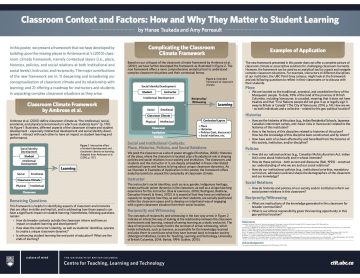Classroom climate is an important consideration because it invites us to consider additional layers of context for situating complex classroom situations. UBC’s Vancouver campus has a multilayered and complex history. This is mirrored by the diversity of perspectives and experiences that exist on this campus. For this reason, UBC classrooms are not static or neutral spaces; rather, they continue to be multidimensional and dynamic spaces where complex interactions occur through the diversity of identities, modes of delivery and places of learning. We approach our work by utilizing the place, history, relationships and institutional contexts we are embedded in acknowledging this brings a rich, reflective and critical lens to our understand of learning.
In How Learning Works, Ambrose, Bridges, DiPietro, Lovett, and Norman (2010) suggest a framework that explains how different dimensions of classroom climate and student development interact with each other to have an impact on student learning. The framework helps us identify classroom factors that play a role in shaping a unique classroom moment and consider how we can create a classroom climate that is conducive to learning. This framework is useful for illuminating and unpacking different aspects of the learning environment and what students bring into it.

Tsukada and Perreault’s conference poster: “Classroom Contexts and Factors: How and Why They Matter to Student Learning”
But additional factors also affect classroom environments and the learning that occurs within them. In our work, we have been building off of Ambrose et. al.’s framework to complicate and suggest additional layers, contexts, and implications to classroom climate. For example, in November 2015, Hanae Tsukada and Amy Perreault presented their conceptualization of classroom climate at a poster session at the POD Network (Professional and Organizational Development Network in Higher Education) conference in San Francisco. Read more about their conference experiences.
Tsukada and Perreault’s poster grew into an article, “Complicating How Classroom Climate Works: Advancing the Framework,” published in Transformative Dialogues: Teaching and Learning Journal (9.2, November 2016).
Article summary (excerpted from abstract)
In the article, we apply the framework to a real classroom situation to identify what the framework does and does not fully capture or articulate. Then, we present an extended framework that includes three new features. First, the framework addresses broader contexts of the classroom, namely institutional and social contexts that carry unique histories, policies, and social relations that are specific to the geographical location. Second, the framework identifies instructors as key players, besides students, in the classroom. Third, the framework introduces the notion of reciprocity to address social implications of learning to extend our focus beyond maximizing student learning. By addressing these points, the article contributes to deepening and broadening our conceptualization of classroom climate and its relationship with learning. Read the full article.
Do you have examples of how the complex layers of classroom climate have affected your own teaching and learning experiences? Please share them with us!